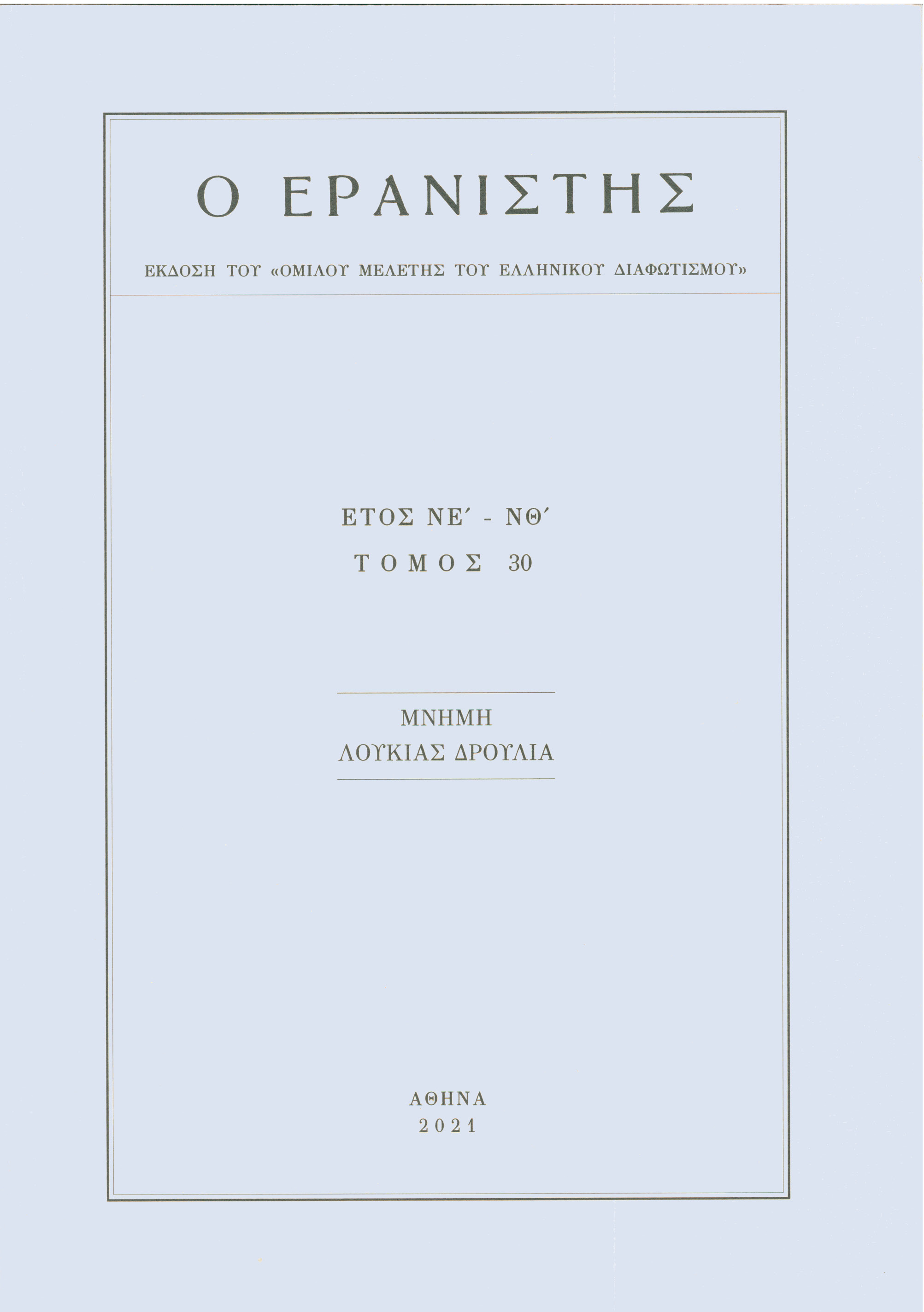Ξετυλίγοντας τον μίτο για την ανασύσταση μιας χαμένης βιβλιοθήκης Τα ελληνικά χειρόγραφα του Δημητρίου Μόστρα

Abstract
Unravelling the thread in order to reconstruct a lost library. Dimitrios Mostras’ Greek manuscripts
The history of Dimitrios Mostras’ library is fascinating. Dimitrios was born in Arta in 1777 or in 1783, studied in his hometown and in Ioannina and worked as a teacher in Arta and in Konitsa. In Arta he made the aquaintance of the bishop of Arta and Nafpaktos Ignatios, who hired him as his secretary. Dimitrios followed him along all the stops of his exciting path: Corfu, Bucharest, Vienna, Pisa. Accompanying Bishop Ignatios was very important for Dimitrios and his intellectual interests. Having this intellectual clergyman’s moral support, Dimitrios turned into an avid book collector and managed to create one of the largest book collections in Greece and in Europe in general. In 1819 Mostras brought all his books in a three-storey house which he had bought earlier in Pisa. The library took up the entire third floor, became very famous and was accessible to everyone, particularly to Greek students in Italy.
When Ignatios died in 1830, Dimitrios went back to Corfu where his siblings lived. He was accompanied by his book collection which in the meantime had gone through a lot and had become wet.
Mostras’ book collection had been created through selling personal possessions and jewelry, and also through accumulating debt. Its owner had very often been pressured by debts and by life’s other needs and had considered selling his dear books with which he had lived for such a long time. However he never did sell them. Among the candidates for buying the books had been the collector Guilford, the Ionian Academy of Corfu, the newly founded University of Athens. Mostras died on January 25,
1850 without having parted with his beloved companions, his books. The books were inherited by his nephews Spyridon and Konstantinos Mostras as well as by Spyridon Komnos, of whom we are not sure whether he was related to Mostras. Those three soon sold their shares of the book collection.
This precious collection consisting of many volumes (12.000 printed books and manuscripts) was dispersed and no comprehensive inventory of it has ever been found. In ca. 1820 Mostras himself mentioned 100 manuscripts in a letter he wrote, while Ignatios in 1825 wrote about «one hundred codices, namely books before the invention of typography and a hundred more manuscripts», of which only four were in Greek. In 1857 Komnos published a catalogue with the title Codices praeclarissimi in membrana et in charta graece, latine, et italice exarati, ut ex titulo cujusdam apparet, apud S. Comnum civem Atheniensem asserrati..., in which he described only four Greek manuscripts, 44 manuscripts in Italian and in Latin, 44 books printed by the publishers Aldo Manutio, Isaac Elzevir and the Giunta family as well as 8 incunabula.
Technology and the digitalisation of Greek manuscripts by the Stavros Niarchos Foundation have helped me follow the course of eight manuscripts, and one more had already been identified by the historian Loukia Droulia, to whom this volume of Eranistis is dedicated.
Mostras’ nephews sold at least five manuscripts to the British Library, that much is proven. These are numbered BL Add. 19058, 19059, 19060, 19062, 19551. Mostras’ four Greek manuscripts that ended up in Komnos’ hands found their way to the Greek National Library. Today they bear the catalogue numbers: National Library of Greece (ΕΒΕ) ms 1238, 1144, 1092 and 1164.
In this study there is an analytical palaeographical description of Mostras’ nine manuscripts, of their owners’ notes as well as of their acquisition notes by the British Library. We hope that the research will reveal even more in the future.
Article Details
- How to Cite
-
Tzivara, P. (2024). Ξετυλίγοντας τον μίτο για την ανασύσταση μιας χαμένης βιβλιοθήκης: Τα ελληνικά χειρόγραφα του Δημητρίου Μόστρα. The Gleaner, (30), 525–566. https://doi.org/10.12681/er.36124
- Section
- Μελετήματα

This work is licensed under a Creative Commons Attribution-NonCommercial-ShareAlike 4.0 International License.
The copyright for articles in this journal is retained by the author(s), with first publication rights granted to the journal. By virtue of their appearance in this open access journal, articles are free to use (with the exception of the non-granted right to make derivative works) with proper attribution for non-commercial uses. The Greek Society for Eighteenth-Century Studies (ΟΜΕΔ) retains the worldwide right to reproduce, display, distribute, and use articles published in THE GLEANER in all formats and media, either separately or as part of collective works for the full term of copyright. This includes but is not limited to the right to publish articles in an issue of the Journal, copy and distribute individual reprints of the articles, authorize reproduction of articles in their entirety in another ΟΜΕΔ’s publication, and authorize reproduction and distribution of articles or abstracts thereof by means of computerized retrieval systems

